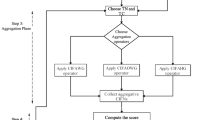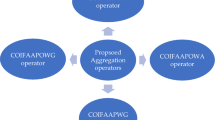Abstract
Intuitionistic fuzzy soft set (IFSS) accommodates more uncertainties within the information by considering the parameterization feature than the intuitionistic fuzzy sets and hence its applications are more extensive. Archimedean T-conorm and T-norm (ATT), consists of T-norm and T-conorm classes, is as an essential source to make the comprehensive operational laws. Meanwhile, the Maclaurin symmetric mean (MSM) has a prominent characteristic and the advantage that it can take into account the interrelation between multi-input arguments, including different attributes or different experts. Motivated by these chief characteristics, in this article, we extend the MSM operators to the IFSS based on ATT. In this paper, a method is exploited to solve the multi-criteria decision-making (MCDM) problems under the IFSS environment. To it, firstly, some generalized intuitionistic fuzzy soft operational laws are introduced based on ATT. Secondly, we reveal some averaging and geometric aggregation operators based on MSM operator. Further, some desirable features and particular cases of it are tested and build up with a new technique for illustrating MCDM problems. Finally, an illustration is given to exhibit the methodology and approach’s supremacy is shown through a comparative study with prevailing techniques.

Similar content being viewed by others
References
Arora R, Garg H (2018a) Prioritized averaging/geometric aggregation operators under the intuitionistic fuzzy soft set environment. Sci Iran 25(1):466–482
Arora R, Garg H (2018b) Robust aggregation operators for multi-criteria decision making with intuitionistic fuzzy soft set environment. Sci Iran E 25(2):931–942
Atanassov KT (1986) Intuitionistic fuzzy sets. Fuzzy Sets Syst 20(1):87–96
Bora M, Neog TJ, Sut DK (2012) Some new operations of intuitionistic fuzzy soft sets. Int J Soft Comput Eng 2:2231–2307
Cagman N, Deli I (2013) Similarity measures of intuitionistic fuzzy soft sets and their decision making. arXiv:1301.0456
Garg H (2019) Hesitant Pythagorean fuzzy Maclaurin symmetric mean operators and its applications to multiattribute decision making process. Int J Intell Syst 34(4):601–626
Garg H (2020a) Linguistic interval-valued Pythagorean fuzzy sets and their application to multiple attribute group decision-making process. Cognit Comput. https://doi.org/10.1007/s12559-020-09750-4
Garg H (2020b) New ranking method for normal intuitionistic sets under crisp, interval environments and its applications to multiple attribute decision making process. Complex Intell Syst 6(3):559–571. https://doi.org/10.1007/s40747-020-00150-7
Garg H, Arora R (2018a) Bonferroni mean aggregation operators under intuitionistic fuzzy soft set environment and their applications to decision-making. J Oper Res Soc 69(11):1711–1724
Garg H, Arora R (2018b) Generalized and group-based generalized intuitionistic fuzzy soft sets with applications in decision-making. Appl Intell 48(2):343–356
Garg H, Arora R (2019) Generalized intuitionistic fuzzy soft power aggregation operator based on t-norm and their application in multi criteria decision-making. Int J Intell Syst 34(2):215–246
Garg H, Arora R (2020a) Algorithms based on COPRAS and aggregation operators with new information measures for possibility intuitionistic fuzzy soft decision-making. Math Probl Eng 2020:1563768. https://doi.org/10.1155/2020/1563768
Garg H, Arora R (2020b) Maclaurin symmetric mean aggregation operators based on t-norm operationsfor the dual hesitant fuzzy soft set. J Ambient Intell Humaniz Comput 11(1):375–410. https://doi.org/10.1007/s12652-019-01238-w
Garg H, Arora R (2020c) TOPSIS method based on correlation coefficient for solving decision-making problems with intuitionistic fuzzy soft set information. AIMS Math 5(4):2944–2966
Garg H, Kumar K (2019) Linguistic interval-valued Atanassov intuitionistic fuzzy sets and their applications to group decision-making problems. IEEE Trans Fuzzy Syst 27(12):2302–2311
Gou XJ, Xu ZS (2017) Exponential operations for intuitionistic fuzzy numbers and interval numbers in multi-attribute decision making. Fuzzy Optim Decis Mak 16(2):183–204
Gou XJ, Xu ZS, Lei Q (2016a) New operational laws and aggregation method of intuitionistic fuzzy information. J Intell Fuzzy Syst 30:129–141
Gou XJ, Xu ZS, Liao HC (2016b) Exponential operations of interval-valued intuitionistic fuzzy numbers. J Mach Learn Cybern 7(3):501–518
Jiang Y, Tang Y, Liu H, Chen Z (2013) Entropy on intuitionistic fuzzy soft sets and on interval-valued fuzzy soft sets. Inf Sci 240:95–114
Jiang H, Zhan J, Chen D (2018) Covering based variable precision (I, T)-fuzzy rough sets with applications to multi-attribute decision-making. IEEE Trans Fuzzy Syst https://doi.org/10.1109/TFUZZ.2018.2883023
Kaur G, Garg H (2018) Multi-attribute decision-making based on Bonferroni mean operators under cubic intuitionistic fuzzy set environment. Entropy 20(1):65. https://doi.org/10.3390/e20010065
Kaur G, Garg H (2019) Generalized cubic intuitionistic fuzzy aggregation operators using t-norm operations and their applications to group decision-making process. Arab J Sci Eng 44(3):2775–2794
Khalid A, Abbas M (2015) Distance measures and operations in intuitionistic and interval-valued intuitionistic fuzzy soft set theory. Int J Fuzzy Syst 17(3):490–497
Klir GJ, Yuan B (2005) Fuzzy sets and fuzzy logic: theory and applications. Prentice Hall of India Private Limited, New Delhi
Liu P, Qin X (2017) Maclaurin symmetric mean operators of linguistic intuitionistic fuzzy numbers and their application to multiple-attribute decision-making. J Exp Theor Artif Intell 29(6):1173–122
Maclaurin C (1729) A second letter to martin folkes, esq; concerning the roots of equations, with demonstration of other rules of algebra. Philos Trans R Soc Lond Ser A 36:59–96
Maji PK, Biswas R, Roy A (2001a) Intuitionistic fuzzy soft sets. J Fuzzy Math 9(3):677–692
Maji PK, Biswas R, Roy AR (2001b) Fuzzy soft sets. J Fuzzy Math 9(3):589–602
Molodtsov D (1999) Soft set theory-first results. Comput Math Appl 27(4–5):19–31
Muthukumar P, Krishnan GSS (2016) A similarity measure of intuitionistic fuzzy soft sets and its application in medical diagnosis. Appl Soft Comput 41:148–156
Qin J, Liu X (2014) An approach to intuitionistic fuzzy multiple attribute decision making based on Maclaurin symmetric mean operators. J Intell Fuzzy Syst 27(5):2177–2190
Qin J, Liu X (2015) Approaches to uncertain linguistic multiple attribute decision making based on dual Maclaurin symmetric mean. J Intell Fuzzy Syst 29(1):171–186
Rajarajeswari P, Dhanalakshmi P (2014) Similarity measures of intuitionistic fuzzy soft sets and its application in medical diagnosis. Int J Math Arch 5(5):143–149
Sarala N, Suganya B (2016) An application of similarity measure of intuitionistic fuzzy soft set based on distance in medical diagnosis. Int J Sci Res 4:2298–2303
Selvachandran G, Maji P, Faisal RQ, Salleh AR (2017) Distance and distance induced intuitionistic entropy of generalized intuitionistic fuzzy soft sets. Appl Intell 47(1):132–147
Wei G, Garg H, Gao H, Wei C (2018) Interval-valued pythagorean fuzzy Maclaurin symmetric mean operators in multiple attribute decision making. IEEE Access 6(1):67866–67884
Wei GW (2010) Some induced geometric aggregation operators with intuitionistic fuzzy information and their application to group decision making. Appl Soft Comput 10:423–431
Wu Q, Wang F, Zhou L, Chen H (2017) Method of multiple attribute group decision making based on 2-dimension interval type-2 fuzzy aggregation operators with multi-granularity linguistic information. Int J Fuzzy Syst 19(6):1880–1903
Wu Q, Wu P, Zhou L, Chen H, Guan X (2018) Some new hamacher aggregation operators under single-valued neutrosophic 2-tuple linguistic environment and their applications to multi-attribute group decision making. Comput Ind Eng 116:144–162
Wu Q, Lin W, Zhou L, Chen Y, Chen H (2019) Enhancing multiple attribute group decision making flexibility based on information fusion technique and hesitant pythagorean fuzzy sets. Comput Ind Eng 127:954–970
Xia MM, Xu ZS, Zhu B (2012) Some issues on intuitionistic fuzzy aggregation operators based on archimedean t-conorm and t-norm. Knowl Based Syst 31:78–88
Xiao P, Wu Q, Li H, Zhou L, Tao Z, Liu J (2019) Novel hesitant fuzzy linguistic multi-attribute group decision making method based on improved supplementary regulation and operational laws. IEEE Access 7:32922–32940
Xu ZS (2007) Intuitionistic fuzzy aggregation operators. IEEE Trans Fuzzy Syst 15:1179–1187
Xu ZS, Yager RR (2006) Some geometric aggregation operators based on intuitionistic fuzzy sets. Int J Gen Syst 35:417–433
Xu ZS, Yager RR (2011) Intuitionistic fuzzy Bonferroni means. IEEE Trans Syst Man Cybern 41(2):568–578
Xue Y, Deng Y, Garg H (2021) Uncertain database retrieval with measure-based belief function attribute values under intuitionistic fuzzy set. Inf Sci 546:436–447
Zadeh LA (1965) Fuzzy sets. Inf Control 8:338–353
Zhan J, Alcantud JCR (2018a) A novel type of soft rough covering and its application to multicriteria group decision making. Artif Intell Rev. https://doi.org/10.1007/s10462-018-9617-3
Zhan J, Alcantud JCR (2018b) A survey of parameter reduction of soft sets and corresponding algorithms. Artif Intell Rev. https://doi.org/10.1007/s10462-017-9592-0
Zhan J, Sun B, Alcantud JCR (2019) Covering based multigranulation (I, T)-fuzzy rough set models and applications in multi-attribute group decision-making. Inf Sci 476:290–318
Author information
Authors and Affiliations
Corresponding author
Additional information
Publisher's Note
Springer Nature remains neutral with regard to jurisdictional claims in published maps and institutional affiliations.
Appendix: Proofs
Appendix: Proofs
Proof of Theorem 3:
Proof
For the sake of simplicity, we prove the result for the generator \(z(t)=-\log (t)\) and \(y(t)=z(1-t).\) Now, for \(z(t)=-\log (t),\) Eq. (7) becomes
Let
and
Now, we will prove function f(k, l) is monotonically diminishing w.r.t. k, l. Since by using Lemma 1, we can get
We proof the result by taking the contraction method. Assume that the f(k, l) is monotonically increasing w.r.t. the parameter k, then we get
But from Eq. (24), we have
Also from Eq. (22), we have
By using Eqns. (25), (26) and (27), we get
Clearly it contradict the inequality given in Lemma 1. Hence, the function f(k, l) is monotonically decreasing w.r.t. the parameter k. Similarly, f(k, l) is monotonically decreasing w.r.t. parameter l and the function g(k, l) is monotonically increasing w.r.t. the parameters k, l. Thus, by applying the definition of score function, we have
For any value of \(k \in [1,n]\) and \(k\in {\mathbb {Z}},\) we can obtain
Since f(k, l) is monotonically decreasing and g(k, l) is monotonically increasing w.r.t. k, therefore, we have \(f(k+1,l)-f(k,l)<0\) and \(g(k+1,l)-g(k,l)> 0.\) This implies \({\text {Sc}}(k+1,l)-{\text {Sc}}(k,l)< 0,\) i.e. for all \(k, {\text {Sc}}(k+1,l)<{\text {Sc}}(k,l).\) Thus the IFSMSMA operator is monotonically decreasing w.r.t. parameter k. Similarly, we can prove IFSMSMA operator is monotonically decreasing w.r.t. parameter l. Hence the result. \(\square \)
Rights and permissions
About this article
Cite this article
Garg, H., Arora, R. Generalized Maclaurin symmetric mean aggregation operators based on Archimedean t-norm of the intuitionistic fuzzy soft set information. Artif Intell Rev 54, 3173–3213 (2021). https://doi.org/10.1007/s10462-020-09925-3
Published:
Issue Date:
DOI: https://doi.org/10.1007/s10462-020-09925-3




